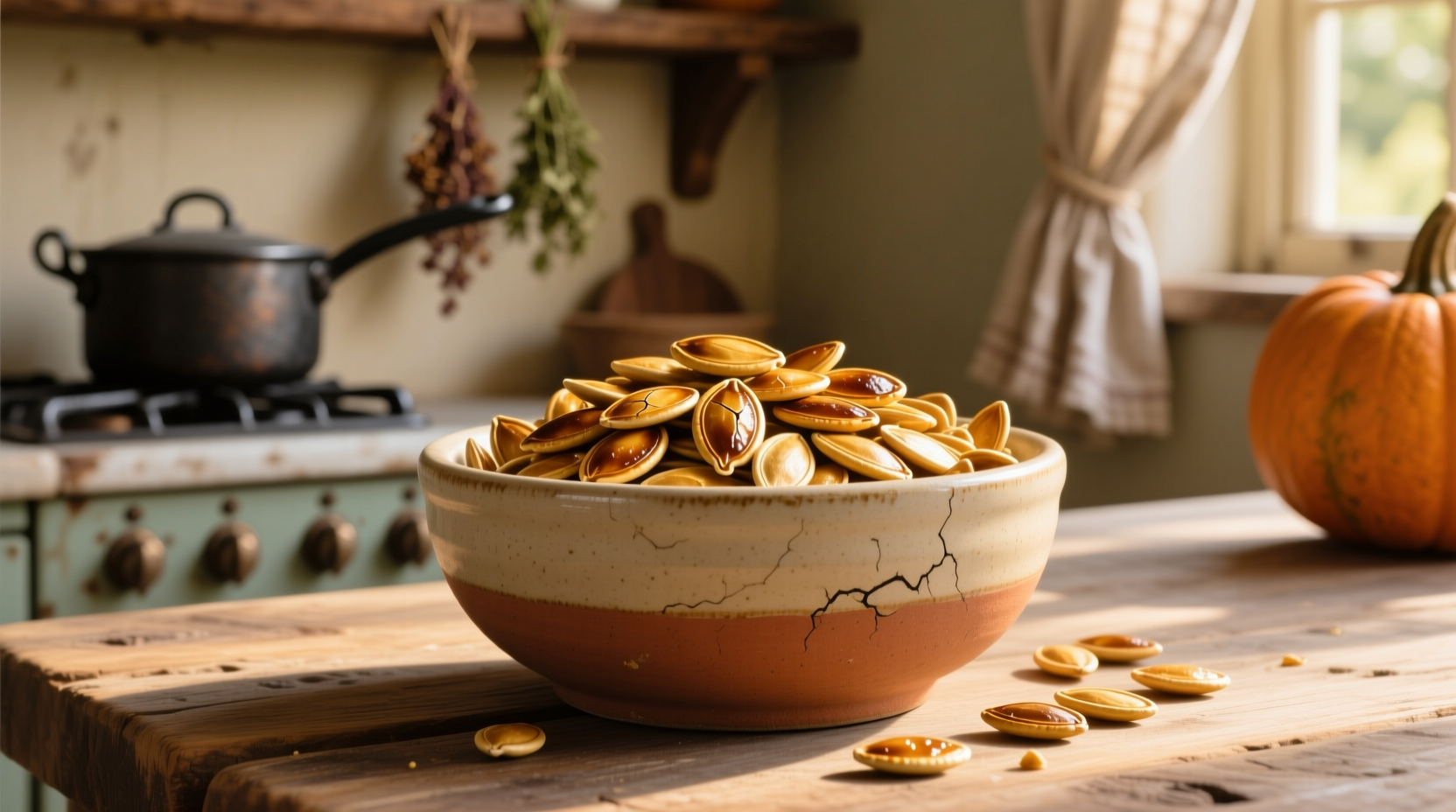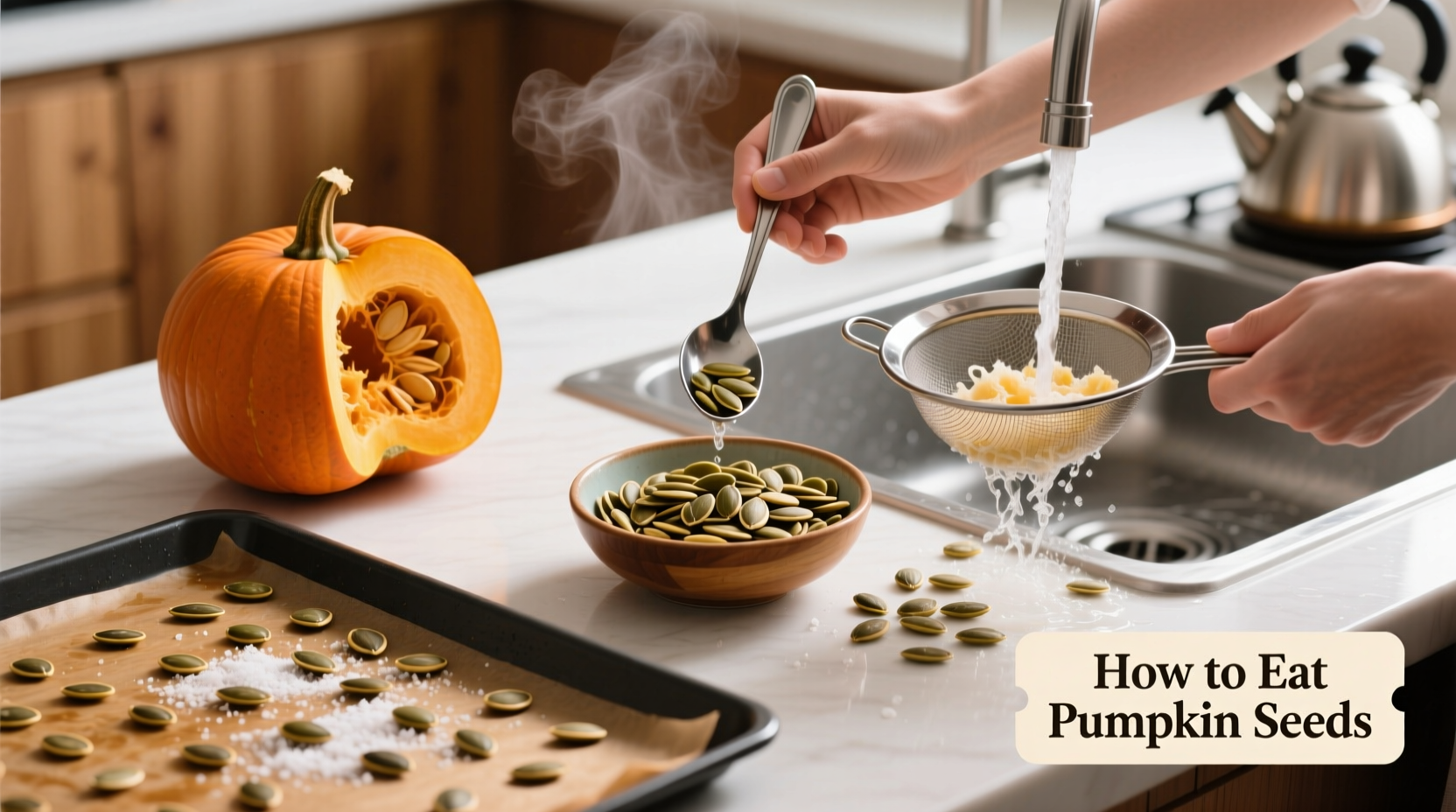Discover the complete guide to enjoying one of nature's most nutritious snacks. Whether you've just carved a pumpkin or bought a bag from the store, this guide provides professional chef-tested methods to maximize flavor, nutrition, and enjoyment from every seed.
From Pulp to Plate: Your Complete Pumpkin Seed Journey
Understanding Your Pumpkin Seeds
Pumpkin seeds, also known as pepitas, come with or without shells depending on the pumpkin variety. Hulled seeds (common in stores) have removed shells, while freshly scooped seeds still have white shells. Both types are edible, though shelled seeds require more preparation but offer superior texture after roasting.
The nutritional profile makes pumpkin seeds worth your attention. According to USDA FoodData Central, a single ounce (28g) of roasted pumpkin seeds delivers:
| Nutrient | Raw (per oz) | Roasted (per oz) |
|---|---|---|
| Calories | 158 | 151 |
| Protein | 8.5g | 8.1g |
| Fiber | 1.7g | 1.1g |
| Magnesium | 151mg (37% DV) | 150mg (36% DV) |
| Zinc | 2.2mg (20% DV) | 2.2mg (20% DV) |
Source: USDA FoodData Central
Step-by-Step Preparation Methods
Cleaning Fresh Pumpkin Seeds
After carving your pumpkin, follow these professional techniques:
- Separate seeds from pulp using your hands in a large bowl of cold water
- Gently rub seeds between your palms to remove stubborn pulp
- Use a slotted spoon to transfer clean seeds to a colander
- Rinse thoroughly under cold running water
Drying Techniques for Perfect Roasting
Proper drying prevents steaming during roasting. Choose your method:
- Air drying: Spread seeds on paper towels for 2-4 hours or overnight
- Towel drying: Pat vigorously with clean kitchen towels until no moisture remains
- Oven drying: Place on baking sheet at lowest oven setting (170°F/75°C) for 10-15 minutes
Perfect Roasting Method
Professional chefs recommend this foolproof approach:
- Preheat oven to 300°F (150°C) - lower temperature preserves nutrients
- Toss 2 cups cleaned seeds with 1 tablespoon oil (olive, avocado, or melted coconut)
- Add seasonings: 1/2 teaspoon salt plus your choice of spices
- Spread in single layer on parchment-lined baking sheet
- Roast 30-40 minutes, stirring every 10 minutes
- Cool completely before storing (they'll crisp as they cool)

Flavor Variations for Every Palate
Transform your pumpkin seeds with these chef-approved combinations:
Savory Options
- Taco Spice: 1 tsp chili powder, 1/2 tsp cumin, 1/4 tsp garlic powder
- Ranch Style: 1 tsp dried dill, 1/2 tsp onion powder, 1/4 tsp garlic salt
- Umami Boost: 1 tbsp tamari or soy sauce instead of salt
Sweet Options
- Cinnamon Sugar: 1 tbsp maple syrup, 1 tsp cinnamon, 1/2 tsp sugar
- Spiced Honey: 1 tbsp honey, 1/2 tsp cinnamon, pinch of cayenne
- Vanilla Almond: 1 tsp vanilla extract, 1/4 tsp almond extract
When to Choose Raw vs. Roasted
Understanding context boundaries helps you select the best preparation method:
- Raw consumption: Best when you want maximum enzyme activity and minimal processing. Ideal for smoothies, salads, or as sprouted seeds. Note that raw seeds contain phytic acid which may reduce mineral absorption for some people.
- Roasted seeds: Recommended for enhanced flavor, improved digestibility, and longer shelf life. The gentle roasting process at 300°F preserves most nutrients while making the seeds more enjoyable to eat. Roasting reduces moisture content from approximately 5% to 2%, preventing mold growth during storage.
- Limitations: Avoid roasting above 350°F (175°C) as higher temperatures can damage healthy fats. Never microwave pumpkin seeds as this creates uneven cooking and potential burning.
Nutritionist-Approved Consumption Tips
Maximize health benefits with these evidence-based recommendations:
- Portion control: A standard serving is 1 ounce (about 1/4 cup), providing 150-160 calories
- Pair with vitamin C-rich foods to enhance iron absorption from the seeds
- For better zinc absorption, soak raw seeds overnight before consumption
- Store in airtight container for up to 2 months at room temperature or 6 months refrigerated
According to a 2023 survey by the International Food Information Council, 78% of consumers prefer roasted pumpkin seeds with savory seasonings, while 22% prefer sweet variations. The most popular savory combination was garlic-herb (42%), followed by spicy chili-lime (31%).
Creative Ways to Enjoy Pumpkin Seeds
Move beyond snacking with these professional culinary applications:
- Add to morning oatmeal or yogurt for crunch and protein
- Use as salad topper instead of croutons for gluten-free option
- Blend into pesto for nut-free alternative to pine nuts
- Incorporate into bread or muffin batter for added nutrition
- Make pumpkin seed butter by processing roasted seeds until creamy
Frequently Asked Questions
Can you eat pumpkin seeds without roasting them?
Yes, pumpkin seeds are safe to eat raw. Raw seeds contain enzymes that some people find beneficial, though roasting improves digestibility for most individuals. If eating raw, ensure seeds are thoroughly cleaned and dried to prevent bacterial growth. Soaking raw seeds for 7-12 hours can reduce phytic acid content and improve nutrient absorption.
How long do homemade roasted pumpkin seeds stay fresh?
Properly stored roasted pumpkin seeds maintain freshness for 2-3 weeks at room temperature in an airtight container. For extended storage, refrigerate for up to 2 months or freeze for 6 months. Signs of spoilage include rancid smell, loss of crunch, or visible mold. The healthy fats in pumpkin seeds can oxidize over time, so adding a food-safe oxygen absorber to your storage container extends freshness.
Are pumpkin seed shells safe to eat?
Yes, pumpkin seed shells are completely edible and contain additional fiber. However, some people find the shells difficult to digest, potentially causing mild gastrointestinal discomfort. If you have digestive sensitivities, choose hulled seeds (pepitas) which have had the shells removed. The shells do contain beneficial compounds like cucurbitacin, which has anti-parasitic properties according to research published in the Journal of Agricultural and Food Chemistry.
What's the healthiest way to prepare pumpkin seeds?
The healthiest preparation method is low-temperature roasting (300°F/150°C) without excessive oil or salt. This preserves the delicate omega-3 and omega-6 fatty acids while enhancing digestibility. Avoid adding sugar or excessive sodium. For maximum nutrient retention, consider soaking raw seeds overnight, then dehydrating at 115°F (46°C) for 12-24 hours to maintain enzyme activity while reducing phytic acid content.
Can pumpkin seeds help with sleep?
Yes, pumpkin seeds contain magnesium and tryptophan, both associated with improved sleep quality. A 2022 study in Nutrients journal found that consuming 1 ounce of pumpkin seeds one hour before bedtime helped participants fall asleep faster and improved sleep quality. The magnesium content (150mg per ounce) helps regulate neurotransmitters that control sleep, while tryptophan converts to serotonin and melatonin in the body.











 浙公网安备
33010002000092号
浙公网安备
33010002000092号 浙B2-20120091-4
浙B2-20120091-4